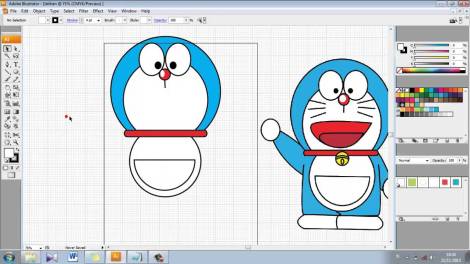I was born when the main means of transport in my country was still bicycle. When I was a little kid, cable television was something only for rich people. Before 2000s, there weren’t many programs on tv, there weren’t many entertainment programs, there were even fewer shows for kids (part of which was the ones to educate socialist patriotism). The only two animated series for kids I can remember are Tom & Jerry and Totally Spies. That was the culture starved period of Vietnam.
Primary school was eyes opening for me, as I moved from the outskirts to the city. Though I never became a comic fan but I was fascinated with the comic starring a chubby robotic cat. Though Doraemon was introduced in Vietnam in 1992, it wasn’t until my first grade that I got to know about Japanese comics in Vietnam. In such context, Doraemon was a blast to the kids, because it was a children entertainment product, a product was purely for entertainment but still contained invaluable lessons, that we could really related to. Then, there’s no wonder why its arrival in Vietnam was a huge phenomenon.
So, how could a comic series become so appealing to a novel-worm like me? The first thing I need to mention is the reason why I didn’t read manga: simple, it hurt my eyes. My parents didn’t like me to read manga so everything I knew about manga was from my classmates, and their favourite kind of manga was something like Conan, which had quite dark tone, complex drawing and lines laying over images. But I couldn’t resist Doraemon since the first glance without knowing why.
When it came to Doraemon, I must have been amazed by the clear presentation of it. Character designs are made of simple strokes and circle, which are absolutely eye-friendly to kids. Besides, the characters look quite real and friendly, which makes it relatable (except for the big round eyes, but the eyes looks really cute tho). And it was also about colour: it’s not until now when I’m watching the anime series that I realise how simple is the colour palette. I was reading it in black and white only, so I guess, it contributed to the clear presentation as well.

source: Internet
I love how relatable the stories were. There was nothing much about the plot, or the context. It all happen in that small town, where the kids were afraid of Jaian’s “angelic” voice and be wowed by Suneo’s wealth. Doraemon has everything one might need but Nobita never learnt how to use them right. The chubby could do anything in the world, from making Suneo lose his face when he sneaked on his friends to sneaking in Shizuka’s bathroom, but no way on earth he could turn Nobita into a good student or a hard-working boy. Every child could find the image of a lazy sleepyhead Nobita in themselves: gluttonous, weak and hopeless. All the characters were just daily people: family, friends and teacher.
But also in that small town, no child was left alone. When Nobita got beaten, Doraemon was always there to support, when Mrs.Nobi worried about Nobita bad grades, Doraemon was also there to console her. When Jaian needed someone to confide in, that blue cat never refused, or when Shizuka-chan need a space to practice playing violin, he created her a tiny world. Just like that, the chubby cat stuck with the kids, helping them with all the most stupid problems. He’s a good listener, someone I could tell all my stories and all my secrets, a friend I was always dreaming of. And that life, though it wasn’t a glamorous life, but there was full of love and care, it’s the life someone already had, but at the same time, the life someone had always been looking for.
Above all the simplicity, it taught me to dream (and daydream). I could immerse my soul into that fantasy world, travelling all over the world, visit all the most magnificent places on earth, build a castle on the cloud or going back time to see dinosaurs. I was dreaming of me caring for the earth and keeping it safe and sound.
I also enjoy the lessons. The lessons weren’t obvious but any child could absorb them. As a kid, I enjoyed stories with nice messages. Fujiko Fujio has taught us that even a bully like Takeshi had to use the fist to protect his friends. Suneo, no matter how sneaky he was, tried his best to help Shizuka when she needed. In that story, every child was a hero in their own ways.
I guess, after all, it’s the relatability that matters most because it was written for kids, and about kids. It was different to what I was mainly reading then, novels and history books. No patriotism, no big things, it was just a real fairy tale about everyday life in a small town in Asia, with homework or with the mess they left when they break someone’s window in a baseball game. When I read the manga, I felt happy, just as happy as the feeling when I’m watching the anime version at the moment.
